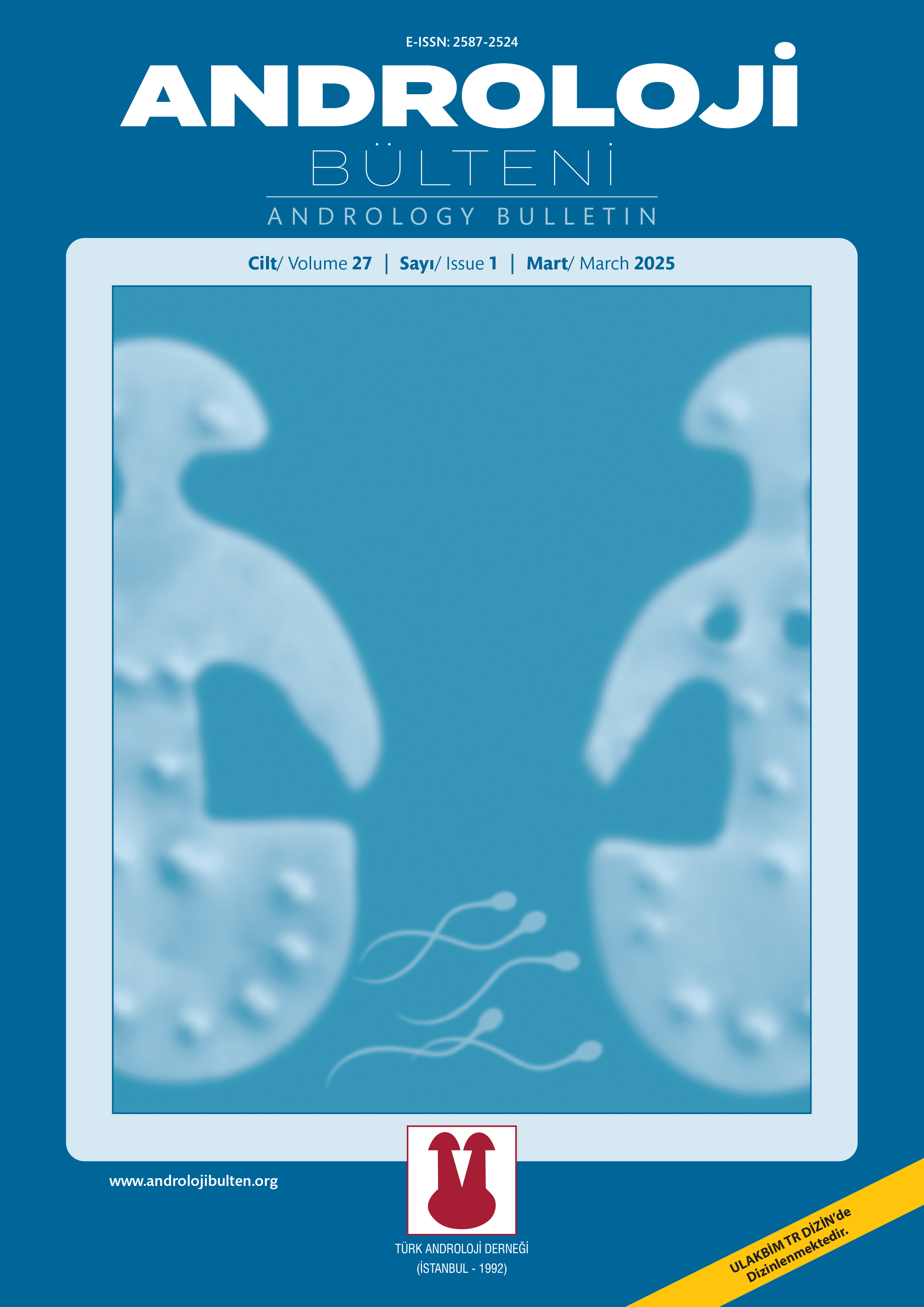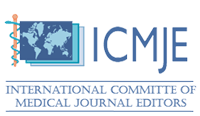INDEXES

Content of this journal is licensed under a Creative Commons Attribution-NonCommercial 4.0 International License.
Volume: 23 Issue: 3 - 2021
| 1. | Cover Page I |
| 2. | Reviewers Pages II - III |
| 3. | From the President Page IV |
| 4. | From the Editor Page V |
| 5. | Contents Page VI |
| ORIGINAL ARTICLE | |
| 6. | Our vasoepididymostomy experience with triangulation method Zafer Tokatlı, Kaan Aydos doi: 10.24898/tandro.2021.69782 Pages 141 - 145 OBJECTIVE: To present the results of end-to-side vasoepididymostomy performed with tubular invagination technique by placing 2 doubleneedle sutures to obtain sperm in ejaculation in cases with azoospermia due to epididymal obstruction. MATRERIAL and METHODS: We evaluated the data of 6 infertile patients who underwent microsurgical vasoepididymostomy (MVE) with the diagnosis of azoospermia due to epididymal obstruction between April 2015 and July 2018. It was confirmed that the semen volume and pH were normal and azoospermia was found in the two sperm analysis performed six weeks apart. Under general anesthesia, an end-to-side anostomosis of the epididymis and the vas deferens was performed using a modified tubular invagination technique using 2 double-needle 10/0 prolene sutures using a surgical microscope. The sperm parameters at 1, 3 and 6 months after surgery were evaluated. The presence of sperm in the ejaculate was considered an anostomosis success. RESULTS: The mean age of the patients was 29 (23–44). Motile sperm were obtained in the ejaculate in 3 (50%) of 6 patients who underwent MVE. Sperm were obtained in 3 months postoperatively in 2 patients and in 6 months postoperatively in one patient. The mean total sperm count obtained from the ejaculate 2×106 (1–3.4×106), and the mean motility was found to be 30% (10%–40%). While the etiology was related to infection in two of the cases where sperm was obtained from the ejaculate, one was idiopathic. CONCLUSION: Vasoepididymostomy performed with tubular invagination technique by placing 2 double-needle sutures in transverse position in infertile men with azoospermia secondary to epididymal obstruction; It has been seen as a safety and effective technique in terms of technical ease, anastomosis stability and providing sperm retrieval in the early period. However, we think that studies in larger series and comparative studies with other techniques are needed to reach a more definite conclusion. |
| 7. | Stigmatization in sexual health and reproductive health from the perspective of young women Nazife Bakır, Pınar Irmak Vural, Cuma Demir doi: 10.24898/tandro.2021.10438 Pages 146 - 151 OBJECTIVE: The study was done in order to determine stigmatization level of young women in sexual health and reproductive health. MATRERIAL and METHODS: The study was undertaken with female course attendees aged 18–24 years at four public education centers in a city located in Mediterranean Region between September 2020 and December 2020. The study data were gathered using Socio-demographic Information Request Form for Women and Sexual and Reproductive Health Stigmatization Scale in Young Women (SRHSSYW). RESULTS: It was identified that 83.6% of the participant women did not work anywhere, 45.0% of them resided in city centers, 73.6% of them had an income equal to expenses and 95.7% of them were single as marital status. It was found that average score of unreal stigmatization subscale of SRHSSYW was statistically and significantly higher among those who worked than those who did not work anywhere. It was identified that average score of internalized stigmatization subscale of SRHSSYW was statistically and significantly higher among those who resided in villages-towns than those who resided in cities and counties. It was seen that average score of external stigmatization subscale of SRHSSYW was statistically and significantly higher among those young participants whose mothers’ educational status was primary school and secondary school than those whose mothers’ educational status was higher education. CONCLUSION: It was seen that average score of external stigmatization subscale of SRHSSYW was 3.97±1.82, average score of unreal stigmatization subscale of SRHSSYW was 1.71±1.81, average score of internalized stigmatization subscale of SRHSSYW was 2.57±1.59 and average total score of SRHSSYW was 8.26±3.84. As a result; it was seen that young women’s total average score of SRHSSYW was below the average. |
| 8. | Investigation of the effects of breast cancer education given to nursing students during undergraduate education on knowledge and attitudes Figen Erol Ursavaş doi: 10.24898/tandro.2021.35762 Pages 152 - 157 OBJECTIVE: The aim of this study is to examine the effects of the education nursing students have received on breast cancer during their undergraduate study on their knowledge and attitudes. MATRERIAL and METHODS: This study was conducted descriptive and cross-sectional design. The sample of the study consisted of 170 2nd, 3rd- and 4th-year students studying in the nursing department of a university located in Central Anatolia. The data were collected via Google Forms between April and May 2020. The data were analyzed by number, percentage, mean, standard deviation, chi square and Anova test in independent groups. RESULTS: It was determined that 100% of the students had breast self-examination (BSE), 81.9% of female students had BSE and 24.4% regularly did it every month. It was determined that mothers of 37.1% of the students had BSE and mothers of 47.6% had not had a mammography before. There was a statistically significant difference between total mean scores of the students for knowledge level of breast cancer risk factors and early diagnosis methods in terms of the grades. CONCLUSION: It was found that attitudes of nursing students toward breast cancer should be improved. |
| 9. | Evaluation of gonadotropin therapy in male infertility caused by idiopathic hypogonadotropic hypogonadism Muhammed Arif İbiş, Kaan Aydos doi: 10.24898/tandro.2021.53254 Pages 158 - 162 OBJECTIVE: To evaluate the efficacy and clinical results of human chorionic gonadotropin (hCG)/human menopausal gonadotropin (hMG) treatment in infertile men diagnosed with idiopathic hypogonadotropic hypogonadism (IHH). MATRERIAL and METHODS: The pre and post treatment data of 60 patients diagnosed with IHH between January 2017 and December 2018 were retrospectively analyzed. The patients were divided into two groups as those with or without pregnancy. Age, body mass index (BMI), testicular volumes, maximum serum total testosterone, follicle stimulating hormone (FSH) and luteinizing hormone (LH) values measured after treatment, and mean hCG and hMG doses and sperm concentrations were compared. RESULTS: After the treatment, there was a significant improvement in hormonal parameters and testicular volume (p<0.001). Spermatozoa were found in 83.3% of the patients. Clinical pregnancy was achieved in 76.7% of the cases, 66.7% by spontaneous pregnancy and 10% by in vitro fertilization (IVF). While the mean sperm concentration was 3.4±1.04 million/ml in cases with pregnancy achieved by ART, it was 12.2±0.68 million/ml in those who were pregnant by spontaneous. A significant difference was found between the cases with and without pregnancy in terms of sperm concentration, testicular volume and serum FSH values (p<0.001, p<0.001 and p=0.029, respectively). CONCLUSION: IHH is one of the rare causes of male infertility that can achieve high success rates with medical treatment. Testicular volumes and FSH values measured after treatment are effective parameters in predicting the success of the treatment. |
| 10. | The self image and sexual adaptation of women undering breast cancer surgery Seçil Taylan, Nurcan Kolaç doi: 10.24898/tandro.2021.79069 Pages 163 - 169 OBJECTIVE: The aim of this study is to determine body image and sexual orientation after breast cancer surgery. MATRERIAL and METHODS: The sample of the descriptive study consisted of 221 women with breast cancer who had undergone breast surgery, who were continuing their routine controls in oncology outpatient clinics of two large hospitals in Istanbul, between 01.12.2020-25.02.2021. The sample calculation method with a known population is updated to 141 with 95% confidence. The Version of the Research, Descriptive Information Form, Sexual Harmony and Body Image Scale are obtained. In the evaluation of the data, descriptive methods, Mann-Whitney U test for comparison of groups, predictor regression analysis was used for diagnostic logistics. RESULTS: The average age of women was 43.25 ± 16.83 years, 79.4% had cancer diagnosis period 1-5 years, 58.1% had lumbectomy as a surgical method, 39.0% had II. stage cancer was determined. When the correlation between Body Image and sexual adjustment subscales was examined, it was found that there was a positive weak correlation between the subsequent body image subscales and the sexual adjustment and the sexual importance of breasts subscale, and a negative weak correlational relationship between the sexual functionality subscale. A statistically significant difference was found in all sub-dimensions of the Sexual Adjustment and Body Image Scale according to the situation of having problems with the spouse after breast cancer. It was determined that women who perceived that they had problems with their spouses had an increase of 1.756 times the next body image score, 1.113 times the breast cancer fear score of the sexual adjustment score, and the sexual importance score of the breasts 3.156 times compared to the women who did not have a problem with their spouse. CONCLUSION: As a result of the study, it was determined that there is a significant difference between body image and sexual harmony and the sexual importance of breasts in women who have undergone breast cancer surgery. Nurses are recommended to provide professional psychosocial support to women after breast cancer surgery. |
| 11. | Sexual problems experienced by patients with stoma: A systematic research Seçil Taylan, İlknur Özkan doi: 10.24898/tandro.2021.32650 Pages 170 - 178 OBJECTIVE: Intestinal stoma has a great impact on the individual, causing problems in sexual life as well as various daily life-related difficulties. The purpose of this systematic review is to determine the sexual life problems of individuals with stoma. MATRERIAL and METHODS: A systematic review was carried out based on the searches of PubMed (MEDLINE), CINAHL, Cochrane Library, PsycINFO, Google Schoolar databases including the articles published between 2000–2020. For the study, articles reporting data from an original study conducted using adult patients undergoing colostomy and ileostomy surgery and sexual life-specific scales were identified as inclusion criteria. RESULTS: A total of 10 articles with 7 descriptive, 1 prospective and 2 experimental methods among the determined 1977 articles were included in the study. 6 different scales specific to sexual life to measure the effect of stoma on sexual life in patients with intestinal stoma (Golombok-Rust Sexual Satisfaction Scale, Female Sexual Function Index, International Erectile Function Index, Arizona Sexual Experiences Scale, Rectal Cancer Female Sexuality Score, Sexual Vaginal Changes Questionnaire) used. It has been found that the patients have sexual life problems and that the presence of ostomy affects their sex lives more than women. While problems such as avoidance of sexuality, decrease in sexual frequency, inability to complete sexual intercourse, orgasm problems were common for both sexes, it was determined that pain during sexual intercourse in women and erection problems in men were gender-specific problems. It has been determined that the nursing intervention is effective in restarting the sexual life of the patients and reaching a solution in their sexual problems. CONCLUSION: Intestinal stoma negatively affects sexual life. This systematic review draws attention to the limited number of literature, despite the positive impact of nursing intervention studies that may support patients’ sexual life problems related to stoma and their adaptation to their sexual life. More research is required in line with the needs of patients. |
| REVIEW | |
| 12. | Knowledge level about sexually transmitted diseases among university students in Turkey: A systematic review Fatma Yıldırım, Nülüfer Erbil doi: 10.24898/tandro.2021.70893 Pages 179 - 186 OBJECTIVE: The aim of this study was to investigate the systematic review of the knowledge level of sexually transmitted diseases (STDs) among university students. MATERIAL and METHODS: This systematic review was conducted by examining the Turkish articles published between 10.11.2019– 15.12.2019 between 2014–2018 to reach related articles: “sexually transmitted disease, young people and university students” keywords were searched and published in Google Scholar, Ulakbim, Türk Medline and Dergi Park search engines. As a result of the screening, 4263 articles were reached and 12 articles were complied with the inclusion criteria. RESULTS: As a result of the examination it was found that the students in the health department generally received information about STDs beforehand. The majority of those who had previously received information about STDs. The majority of those who had previous knowledge were found to have sufficient knowledge of STD. The knowledge level of the students in the health department was found to be moderate or sufficient. Among the students, AIDS was the most known STD. CONCLUSION: Most of the students had insufficient knowledge about STDs. In general, students with moderate and sufficient level of knowledge consisted of students in the health department. |
| 13. | Sexual health and counseling in the postpartum period: Using the BETTER model Seda Çetin Avcı, Zeynep Daşıkan doi: 10.24898/tandro.2021.12144 Pages 187 - 196 Sexuality is a complex concept that starts before birth and continues throughout life, and is affected and shaped by many factors. Sexuality can change by being constantly affected by the developmental periods and different events in the life of the individual. Changes in women in the postpartum period, changing roles and responsibilities can negatively affect women’s sexual lives, sexual desire and satisfaction. Evaluation of sexuality, sexual education and counseling should be a part of routine postpartum care and this issue should be given importance. The use of a model in the evaluation of sexuality facilitates the anamnesis process. It also helps healthcare personnel to speak about sexuality more comfortably. Sexual health trainings and counseling based on PLISSIT (Permission (P), Limited Information (LI), Specific Suggestions (SS), Intensive Therapy (IT)), BETTER (Bringing up the topic (B), Explain you are concerned with quality-of-life issues, including sexuality (E), Telling patients that resources will be found to adres their concerns (T), Timing of intervention (T), Educate patients about the side effects of their cancer treatments (E), Recording (R)), REDI, Levine models seem to be effective in evaluation and improving postpartum sexual health. For this reason, health professionals should evaluate women’s sexuality and provide consultancy by using one of these models in postpartum care. In the last study, it was found that the BETTER model is more effective than the PLISSIT model in expressing postpartum sexual problems. Based on this result, the use of consultancy based on the BETTER model should be increased. The aim of this review is to address sexual health, sexual counseling in the postpartum period in line with the literatüre and create an example of sexual counseling using the BETTER model. |
| 14. | Optimization of the efficacy of PDE5 inhibitors Mustafa Kadıhasanoğlu doi: 10.24898/tandro.2021.38802 Pages 197 - 205 Phosphodiesterase type 5 (PDE5) inhibitors are the most preferred firstline agents in treatment of erectile dysfunction. On-demand PDE5 inhibitors are 60–70% successful in patients with ED. Although 30% of patients fail to respond to PDE5 inhibitors, 30–50% of non-responders can be salvaged with detailed information on proper use of drugs, sufficient dosage and adequate clinical trials. Despite of this counselling, patients who are unresponsive to PDE5 inhibitors require other medical applications to increase the effectiveness of the treatment rather than using more invasive methods. Correct diagnosis of these unresponsive cases and the identification of the factors affecting of drug response are the first step in evaluation of non-responders. Medication usage changes and combining PDE5 inhibitors with other treatment modalities are options that can be applied to reduce unresponsiveness and increase the effectiveness of PDE5 inhibitors. In this review, the evaluation of patients who do not respond to on-demand PDE5 inhibitors and the methods that can be applied for these cases will be reviewed in the light of the literature. |
| 15. | Usage of complementary medicine in male infertility: What is the level of evidence? Coşkun Kaçağan, Halil Lütfi Canat doi: 10.24898/tandro.2021.10327 Pages 206 - 213 The etiologies of approximately half of the male factor related infertility is still unclear. In addition to the modern medicine treatments, complementary medicine options are preferred frequently in the treatment of idiopathic infertility. With the increasing use of complementary medicine in modern medicine, these herbal agents are frequently preferred by patients. Anti-oxidant and phytotherapeutic agents can be recommended to subfertile men as a part of assisted reproductive methods although there is not enough evidence about live birth and pregnant rates. Further studies are needed to demonstrate the efficacy of complementary medicine agents in the treatment of male infertility. |
| 16. | Publications and Congress Calendar of Andrology Pages 214 - 218 Abstract | |














